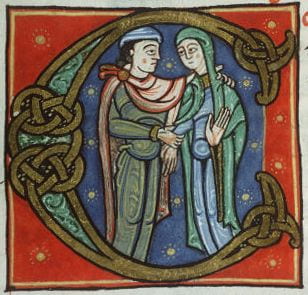Well, this one’s very nasty (be warned – violence, and abusive sexual behaviour), but also interesting from a legal history point of view, so worthy of a quick note.
It’s in the gaol delivery roll for a session at Lincoln castle on 1st August, 1392, which contains a series of allegations against Robert de Spalding, tailor, living in Horbling.[i] Sadly, the roll has a big chunk missing from the right hand side, but there is still enough to reconstruct the charges.
In July 1391, Robert had been arrested for homicide, in relation to a newborn (and unbaptised) child, in a house in Horbling. That in itself is pretty horrible, but there was more. The entry notes that Robert had two (apparently living) wives, the first somewhere in Holland (Lincs, not Netherlands) and the second at Folkingham (also Lincs), but even so, on a Sunday in November 1390, he had taken his biological daughter Agnes, shut all of the windows and doors and raped her [the entry on the roll mentions force and the fact that this was conttrary to Agnes’s will]. It goes on to say that he continued in this sin [it’s definitely singular] with the result that Agnes became pregnant. When the time came for the baby to be born, on Wednesday 28th June, 1391, in a house at Horbling, Robert shut all the windows and doors again, and drew his knife on the prostrate Agnes, swearing by the body of Christ that if she made any noise, he would kill her (so that nobody would learn of his misconduct). In this way, Agnes gave birth to the ‘creature’ which on that day, Robert killed and buried at the same house.
Robert was found ‘guilty of the felonies’ with which he was charged, and was hanged.
Points of interest
It often seems to me that the most surprising and interesting material comes out of situations like this, when we are dealing with a bit of ‘freestyling’ on the part of those who drew up the accusations. There is a fair bit here which goes beyond what was legally necessary – if we strip it all down, all that was needed for a capital trial in this case was the allegation that Robert had killed the baby, or a charge that he had raped Agnes (though, if you’ve spent any time with medieval records, you’ll know that that does not tend to end with a conviction). The rest of it – the two wives, the incest, the swearing and the threats – was not really needed. For some reason, though, those drawing up the indictment, and the clerk recording the session, decided to give us the whole story, granting us unusual access to the thoughts of medieval laymen. We see disapproval of bigamy and incest – and despite the fact that there seems to have been continuing sexual activity, only Robert, and not Agnes, is blamed for it (I don’t think that would have been the case in non-incest situations, and it is rather at odds with other statements in common law sources in which pregnancy was said to be impossible without the woman’s consent/pleasure).
Although the bigamy and incest were not strictly the felonies which ended up ending Robert, it is interesting that they were brought up. Each year, rather glibly perhaps, in the part of the Legal History unit dealing with sexual offences, I tell my students that bigamy and incest weren’t within the scope of the medieval common law: they were left to the church. It looks as if medieval people did not always make that neat jurisdictional distinction. Certainly something to think about.
From a human point of view, I do hope that things improved for Agnes after this – but rather fear that she would have been left in a poor position. She did not even get Robert’s property, for his chattels (1 mark) were forfeit, as was usual after a felony conviction.
GS
11/4/2021
Picture: Lincoln Castle, Lincoln © Dave Hitchborne cc-by-sa/2.0 :: Geograph Britain and Ireland
[i] JUST 3/177 m. 83 (AALT IMG 179) which you can see at AALT Page (uh.edu)

